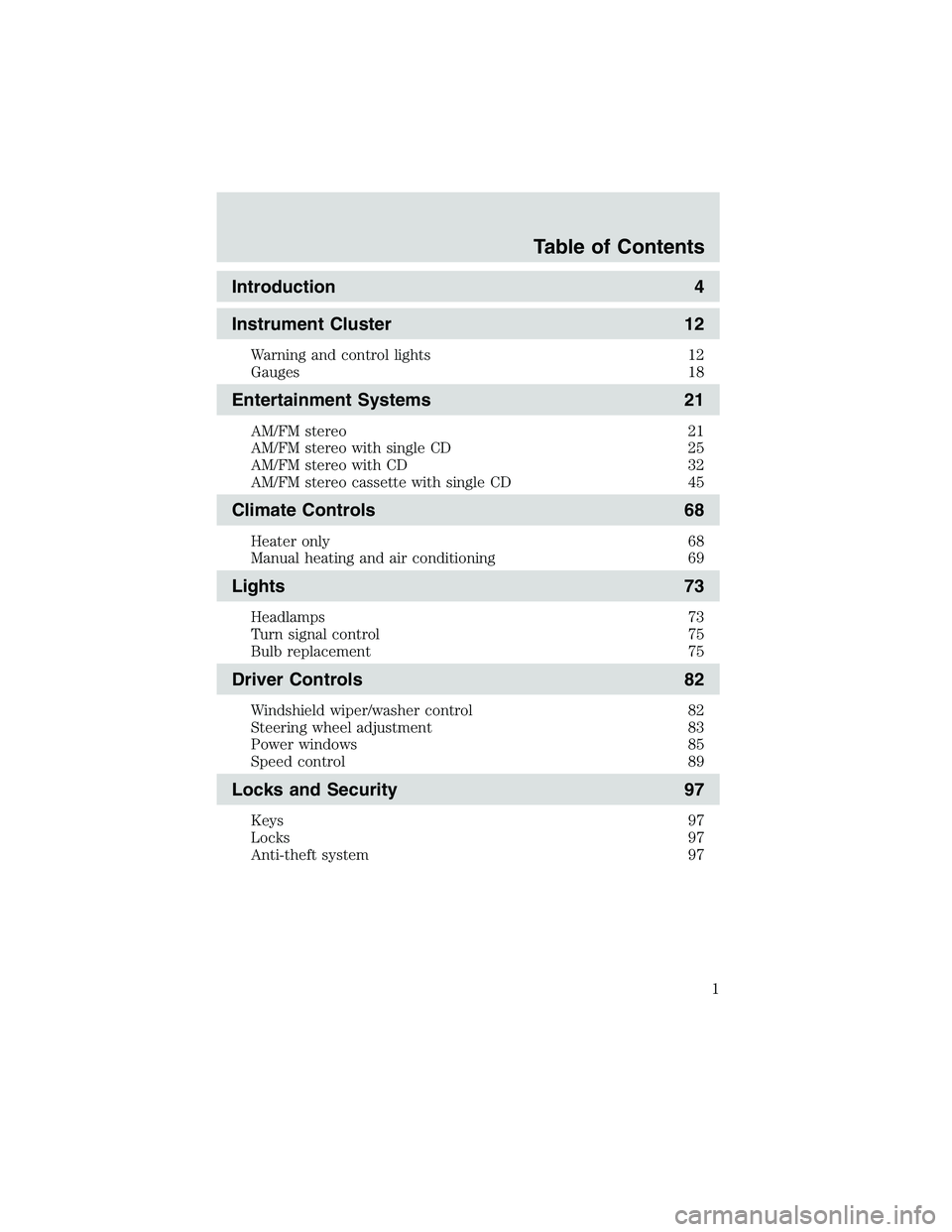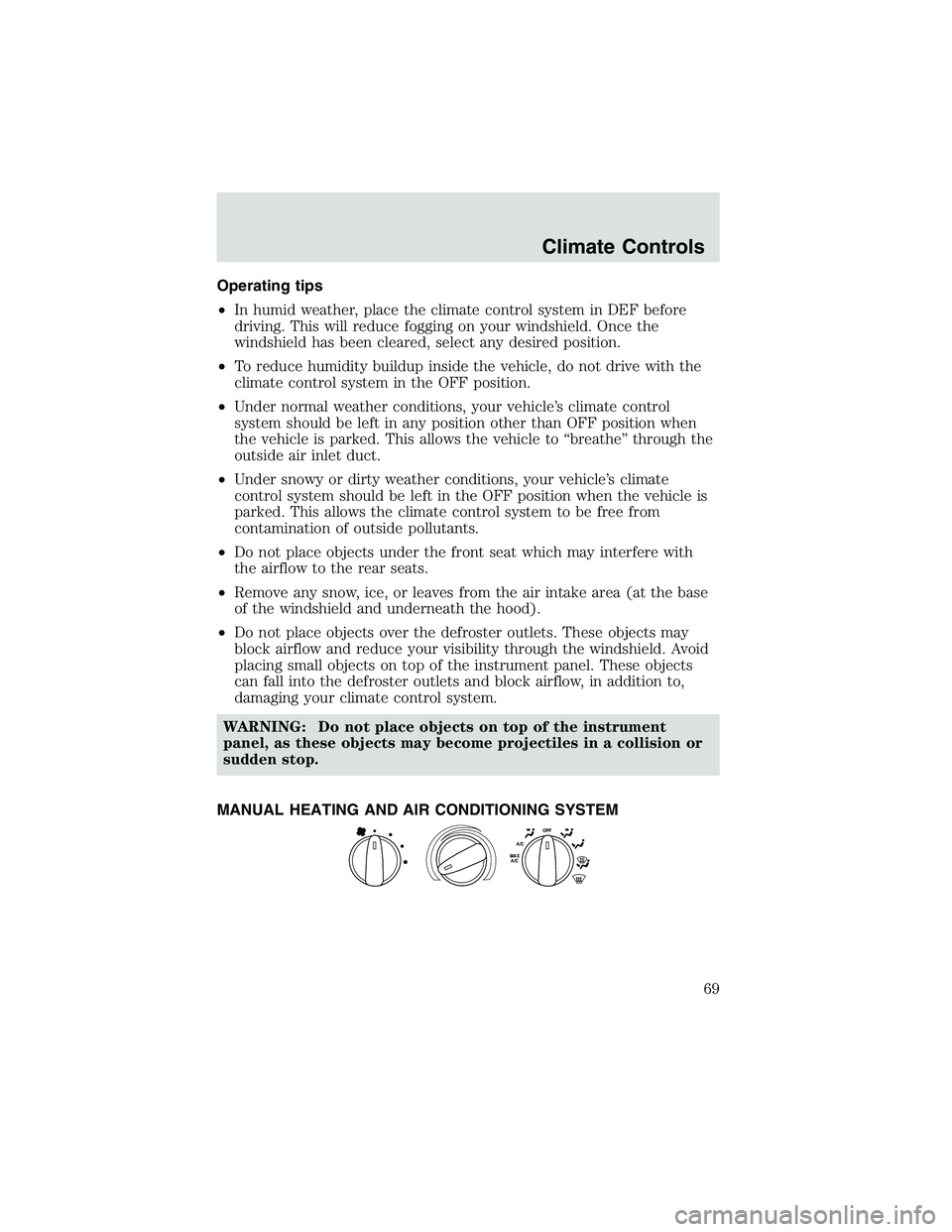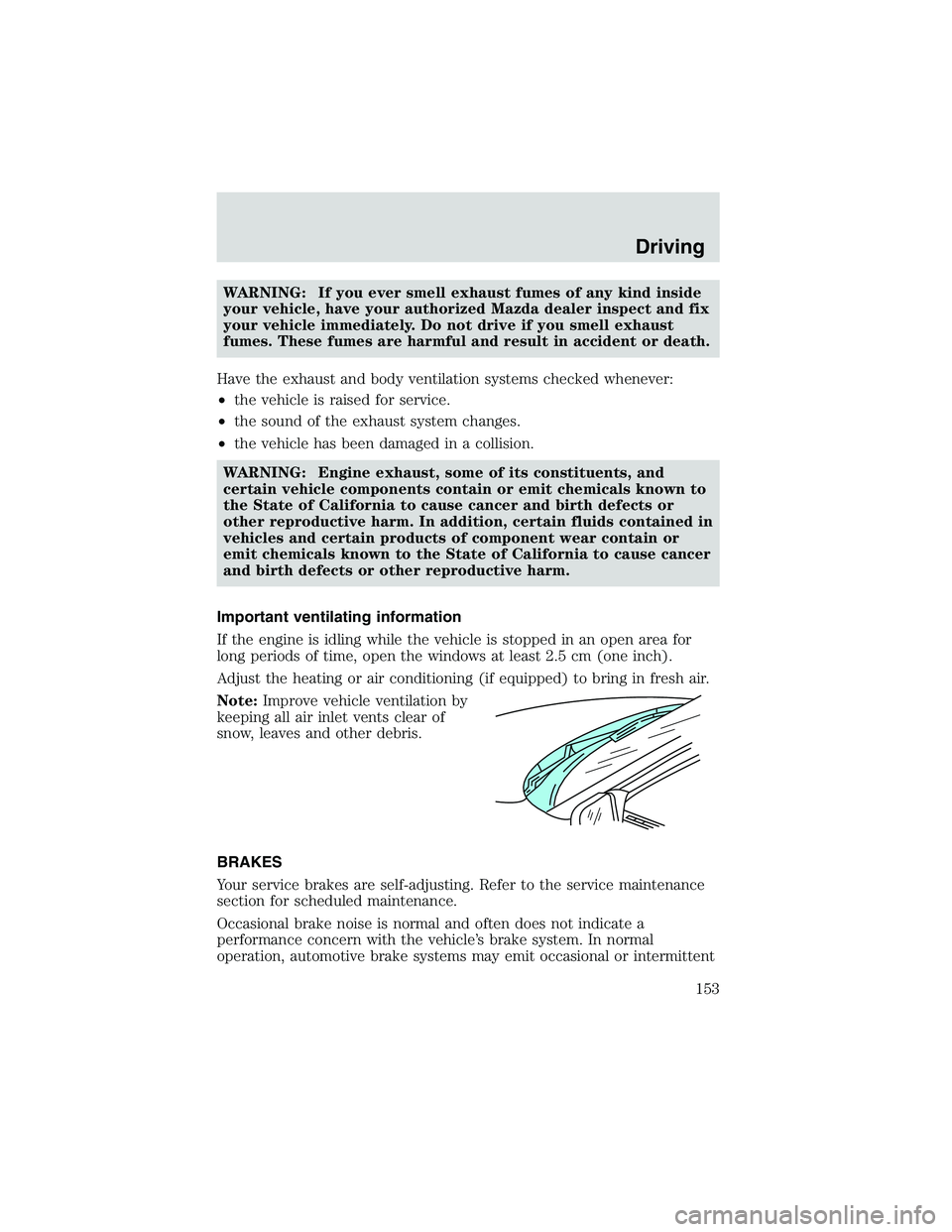heating MAZDA MODEL B3000 4WD 2002 Owners Manual
[x] Cancel search | Manufacturer: MAZDA, Model Year: 2002, Model line: MODEL B3000 4WD, Model: MAZDA MODEL B3000 4WD 2002Pages: 288, PDF Size: 1.87 MB
Page 1 of 288

Introduction4
Instrument Cluster 12
Warning and control lights 12
Gauges 18
Entertainment Systems21
AM/FM stereo 21
AM/FM stereo with single CD 25
AM/FM stereo with CD 32
AM/FM stereo cassette with single CD 45
Climate Controls68
Heater only 68
Manual heating and air conditioning 69
Lights73
Headlamps 73
Turn signal control 75
Bulb replacement 75
Driver Controls82
Windshield wiper/washer control 82
Steering wheel adjustment 83
Power windows 85
Speed control 89
Locks and Security97
Keys 97
Locks 97
Anti-theft system 97
Table of Contents
1
Page 18 of 288

GAUGES
Engine coolant temperature gauge
Indicates the temperature of the
engine coolant. At normal operating
temperature, the needle remains
within the normal area (the area
between the “H” and “C”).
If it enters the red section, the
engine is overheating. Stop the
vehicle as soon as safely
possible, switch off the engine
immediately and let the engine cool.
Refer toEngine coolant in theMaintenance and specifications
chapter.
WARNING: Never remove the coolant reservoir cap and/or the
radiator cap while the engine is running or hot, this may result
in serious burns.
NOTE: This gauge indicates the temperature of the engine coolant, not
the coolant level. If the coolant is not at its proper level the gauge
indication will not be accurate.
C
H
Instrument Cluster
18
Page 69 of 288

Operating tips
•In humid weather, place the climate control system in DEF before
driving. This will reduce fogging on your windshield. Once the
windshield has been cleared, select any desired position.
• To reduce humidity buildup inside the vehicle, do not drive with the
climate control system in the OFF position.
• Under normal weather conditions, your vehicle’s climate control
system should be left in any position other than OFF position when
the vehicle is parked. This allows the vehicle to “breathe” through the
outside air inlet duct.
• Under snowy or dirty weather conditions, your vehicle’s climate
control system should be left in the OFF position when the vehicle is
parked. This allows the climate control system to be free from
contamination of outside pollutants.
• Do not place objects under the front seat which may interfere with
the airflow to the rear seats.
• Remove any snow, ice, or leaves from the air intake area (at the base
of the windshield and underneath the hood).
• Do not place objects over the defroster outlets. These objects may
block airflow and reduce your visibility through the windshield. Avoid
placing small objects on top of the instrument panel. These objects
can fall into the defroster outlets and block airflow, in addition to,
damaging your climate control system.
WARNING: Do not place objects on top of the instrument
panel, as these objects may become projectiles in a collision or
sudden stop.
MANUAL HEATING AND AIR CONDITIONING SYSTEM
OFFA/CMAX A/C
Climate Controls
69
Page 71 of 288

•OFF – Outside air is shut out and the fan will not operate. For short
periods of time only, use this mode to prevent undesirable odors from
entering the vehicle.
•
(Panel and floor) – Distributes outside air through the
instrument panel registers and the floor ducts. Heating and air
conditioning capabilities are provided in this mode. For added
customer comfort, when the temperature control knob is anywhere in
between the full hot and full cold positions, the air distributed through
the floor ducts will be slightly warmer than the air sent to the
instrument panel registers.
•
(Floor) – Distributes outside air through the floor ducts.
However, the air will not be cooled below the outside temperature
because the air conditioning does not operate in this mode.
•
(Floor and defrost) – Distributes outside air through the
windshield defroster ducts and the floor ducts. Heating and air
conditioning capabilities are provided in this mode. For added
customer comfort, the air distributed through the floor ducts will be
slightly warmer than the air sent to the windshield defroster ducts. If
the temperature is about 6°C (43°F) or higher, the air conditioner will
automatically dehumidify the air to reduce fogging.
•
(Defrost) – Distributes outside air through the windshield
defroster ducts. It can be used to clear ice or fog from the windshield.
If the temperature is about 6°C (43°F) or higher, the air conditioner
will automatically dehumidify the air to reduce fogging.
Operating tips
• In humid weather conditions, place the climate control system in
Defrost mode before driving. This will reduce fogging on your
windshield. Once the windshield has been cleared, operate the climate
control system as desired.
• To reduce humidity buildup inside the vehicle in cold weather
conditions, don’t drive with the climate control system in the OFF or
MAX A/C position.
• To reduce humidity buildup inside the vehicle in warm weather
conditions, don’t drive with the climate control system in the OFF
position.
• Under normal weather conditions, your vehicle’s climate control
system should be left in any position other than the MAX A/C or OFF
when the vehicle is parked. This allows the vehicle to “breathe”
through the outside air inlet duct.
Climate Controls
71
Page 153 of 288

WARNING: If you ever smell exhaust fumes of any kind inside
your vehicle, have your authorized Mazda dealer inspect and fix
your vehicle immediately. Do not drive if you smell exhaust
fumes. These fumes are harmful and result in accident or death.
Have the exhaust and body ventilation systems checked whenever:
• the vehicle is raised for service.
• the sound of the exhaust system changes.
• the vehicle has been damaged in a collision.
WARNING: Engine exhaust, some of its constituents, and
certain vehicle components contain or emit chemicals known to
the State of California to cause cancer and birth defects or
other reproductive harm. In addition, certain fluids contained in
vehicles and certain products of component wear contain or
emit chemicals known to the State of California to cause cancer
and birth defects or other reproductive harm.
Important ventilating information
If the engine is idling while the vehicle is stopped in an open area for
long periods of time, open the windows at least 2.5 cm (one inch).
Adjust the heating or air conditioning (if equipped) to bring in fresh air.
Note: Improve vehicle ventilation by
keeping all air inlet vents clear of
snow, leaves and other debris.
BRAKES
Your service brakes are self-adjusting. Refer to the service maintenance
section for scheduled maintenance.
Occasional brake noise is normal and often does not indicate a
performance concern with the vehicle’s brake system. In normal
operation, automotive brake systems may emit occasional or intermittent
Driving
153
Page 265 of 288
![MAZDA MODEL B3000 4WD 2002 Owners Manual The transmission fluid should be in
this range if at ambient temperature
(10°C-35°C [50°F-95°F]).
High fluid level
Fluid levels above the safe range
may result in transmission failure.
An overfill MAZDA MODEL B3000 4WD 2002 Owners Manual The transmission fluid should be in
this range if at ambient temperature
(10°C-35°C [50°F-95°F]).
High fluid level
Fluid levels above the safe range
may result in transmission failure.
An overfill](/img/28/41052/w960_41052-264.png)
The transmission fluid should be in
this range if at ambient temperature
(10°C-35°C [50°F-95°F]).
High fluid level
Fluid levels above the safe range
may result in transmission failure.
An overfill condition of transmission
fluid may cause shift and/or
engagement concerns and/or
possible damage.
High fluid levels can be caused by an overheating condition.
Adjusting automatic transmission fluid levels
Before adding any fluid, make sure the correct type is used. The type of
fluid used is normally indicated on the dipstick and also in the
Lubricant specificationssection in this chapter.
Use of a non-approved automatic transmission fluid may cause
internal transmission component damage.
If necessary, add fluid in 250 ml (1/2 pint) increments through the filler
tube until the level is correct.
If an overfill occurs, excess fluid
should be removed by a qualified
technician.
An overfill condition of
transmission fluid may cause
shift and/or engagement concerns and/or possible damage.
Do not use supplemental transmission fluid additives, treatments or
cleaning agents. The use of these materials may affect transmission
operation and result in damage to internal transmission components.
Maintenance and Specifications
265
Page 280 of 288

A
ABS (see Brakes) .....................154
Air bag supplemental restraint
system ................................119–120and child safety seats ............122
description ..............................120
disposal ....................................126
driver air bag ..........................124
indicator light .............14–15, 125
operation .................................124
passenger air bag ...................124
passenger deactivation
switch ......................................126
Air conditioning manual heating and air
conditioning system .................69
Ambulance packages ....................7
Antifreeze (see Engine
coolant) .....................................245
Anti-lock brake system
(see Brakes) ......................154–155
Anti-theft system warning light .............................16
Audio system
(see Radio) ......................21, 45, 53
Automatic transmission ............158 driving an automatic
overdrive .................................159
fluid, adding ............................263
fluid, checking ........................263
fluid, refill capacities ..............272
fluid, specification ..................276
Auxiliary power point .................84
Axle lubricant specifications ..275–276
refill capacities ........................272
traction lok ..............................157
B
Battery .......................................243 acid, treating emergencies .....243
charging system warning
light ............................................15
jumping a disabled battery ....201
maintenance-free ....................243
servicing ..................................243
voltage gauge ............................19
Bed extender ..............................95
BeltMinder .................................115
Brakes ........................................153 anti-lock ...........................154–155
anti-lock brake system (ABS)
warning light .....................14, 155
brake warning light ..................13
fluid, checking and adding ....262
fluid, refill capacities ..............272
fluid, specifications .........275–276
lubricant specifications ..275–276
parking ....................................155
shift interlock ..........................158
Break-in period .............................5
Bulbs ............................................75
C
Capacities for refilling fluids ....272
Cargo area shade ........................95
Cargo net .....................................95
CD-6 disc .....................................53
CD-single .....................................25
CD-single premium .....................45
Cell phone warning ...................279
Certification Label ....................278
Changing a tire .........................194
Child safety restraints ..............132 child safety belts ....................132
Child safety seats ......................135
Index
280
Page 281 of 288

attaching with tether straps ..140
in front seat ............................136
in rear seat ......................136, 139
LATCH .....................................145
tether anchorage hardware ...140
Cleaning your vehicle engine compartment ..............219
exterior ....................................223
instrument cluster lens ..........222
instrument panel ....................222
interior .....................................222
mirrors .....................................221
plastic parts ............................221
washing ....................................218
waxing .....................................218
wheels ......................................219
wiper blades ............................221
Climate control (see Air
conditioning or Heating) ......68–69
Clock ....................24, 31, 44, 52, 64
Clutch fluid ..........................................263
operation while driving ..........162
recommended shift speeds ....164
Compass, electronic ..............86–87 calibration .................................88
set zone adjustment .................87
Console ........................................94
Coolant checking and adding ..............245
refill capacities ................249, 272
specifications ..................275–276
Cruise control (see Speed
control) ........................................89
Customer
Assistance ..........181, 207–208, 211 Ford accessories for your
vehicle .....................................223
Getting roadside assistance ...181 D
Daytime running lamps
(see Lamps) ................................73
Dipstick
automatic transmission
fluid ..........................................263
engine oil .................................238
Doors door ajar warning .....................16
lubricant specifications ..........275
Driveline universal joint and
slip yoke ....................................267
Driving under special
conditions ..........................168–169 mud ..........................................168
sand .........................................168
snow and ice ...........................169
through water .................168, 170
E
Emergencies, roadside jump-starting ..........................201
Emission control system ..........259
Engine ........................................276 check engine/service engine
soon light ..................................12
cleaning ...................................219
coolant .....................................245
idle speed control ...................243
lubrication
specifications ..................275–276
refill capacities ........................272
service points ..................234–236
starting after a collision .........182
Engine block heater .................152
Engine oil ..................................238 checking and adding ..............238
dipstick ....................................238
Index
281
Page 283 of 288

warning chime ..........................17
Heating heater only system ...................68
heating and air conditioning
system .......................................69
Hood ..........................................233
I
Ignition ...............................148, 276
Infant seats (see Safety seats)..135
Inspection/maintenance (I/M)
testing ........................................260
Instrument panel cleaning ...................................222
cluster ................................12, 222
lighting up panel and interior...74
location of components ............12
J
Jack ............................................194 positioning ...............................194
storage .............................194–197
Jump-starting your vehicle ......201
K
Keys ...................................102–103 key in ignition chime ...............17
positions of the ignition .........148
L
Lamps bulb replacement
specifications chart ..................76
cargo lamps ...............................74
daytime running light ...............73
fog lamps ...................................73 headlamps .................................73
headlamps, flash to pass ..........74
instrument panel, dimming .....74
interior lamps .....................75–76
replacing bulbs.. 75, 77–78, 80–81
Lane change indicator (see
Turn signal) .................................75
LATCH anchors .........................145
Lights, warning and indicator ....12 air bag ..................................14–15
anti-lock brakes (ABS) ....14, 155
anti-theft ...................................16
brake ..........................................13
charging system ........................15
check coolant ............................13
check engine .............................12
cruise indicator .........................15
door ajar ....................................16
fuel cap light .............................15
high beam .................................16
overdrive off ..............................16
safety belt .................................14
speed control ............................93
turn signal indicator .................16
Limited slip axle
(see Traction Loc) ....................157
Load limits .................................170 GAWR ......................................170
GVWR ......................................170
trailer towing ..........................170
Loading instructions .................172
Lubricant specifications ...275–276
Lumbar support, seats .............106
M
Manual transmission .................162 fluid capacities ........................272
lubricant specifications ..........276
reverse .....................................164
Index
283